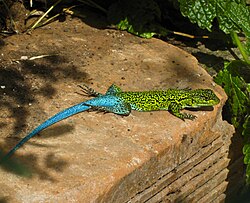Liolaemidae
| Liolaemidae | |
|---|---|

| |
| male Liolaemus tenuis | |
| Scientific classification | |
| Domain: | Eukaryota |
| Kingdom: | Animalia |
| Phylum: | Chordata |
| Class: | Reptilia |
| Order: | Squamata |
| Suborder: | Iguania |
| Family: | Liolaemidae Frost & Etheridge, 1989 |
| Synonyms | |
|
Liolaeminae (but see text) | |
Liolaemidae are a family of iguanian lizards.[1] They were traditionally included in the family Iguanidae as subfamily Liolaeminae, which some more recent authors prefer to delimit in a more restricted way. This family is only found within South America with the widest range being in Argentina, Bolivia, Brazil, Chile, Peru, Uruguay, and Paraguay[2]. A common name for this group is liolaemids. Liolaemidae are typically herbivores that have a diet high in fruit. Because of this special diet, Liolaemidae have a larger small intestine when compared to other similar omnivorous and insectivorous lizards.[3] Liolaemidae also have evolved both herbivory and omnivory independently more times than any other lizard group[2]
The genera placed here are:
- Ctenoblepharys Tschudi, 1845 – cabezona (one species)
- Liolaemus Wiegmann, 1834 – tree iguanas, snow swifts (over 280 species)
- Phymaturus Gravenhorst, 1838 (52 species)
References
[edit]- ^ Uetz, P.; et al. (eds.). "Liolaemidae". The Reptile Database. Retrieved 12 July 2019.
- ^ a b Pinchiera-Donoso, Daniel; Scolaro, Jose Alejandro; Sura, Piotr (2008). A monographic catalogue on the systematics and phylogeny of the South American iguanian lizard family Liolaemidae (Squamata, Iguania). Magnolia Press. pp. 4–6, 7.
- ^ O'Grady, Shannon P. (2005). "Correlating diet and digestive tract specialization: Examples from the lizard family Liolaemidae". Zoology. 108 (3). Urban & Fischer: 201–210. doi:10.1016/j.zool.2005.06.002. PMID 16351968.
 Media related to Liolaemidae at Wikimedia Commons
Media related to Liolaemidae at Wikimedia Commons Data related to Liolaemidae at Wikispecies
Data related to Liolaemidae at Wikispecies
